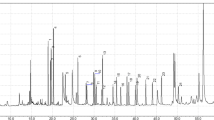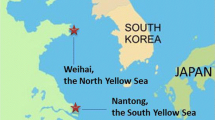Abstract
The simultaneous determination of 8 polychlorinated biphenyls (PCBs), 23 organic chlorine pesticides (OCPs), and 35 polycyclic aromatic hydrocarbons (PAHs) in black-tailed gull eggs was described using ultrasound-assisted extraction and gas chromatography–tandem mass spectrometry (GC–MS/MS). The ranges of the lower limits of detection for PCBs, OCPs, and PAHs were 0.006–0.029, 0.01–0.10, and 0.01–0.20 μg kg−1, respectively. The intraday precision was in the range of 0.650–12.9% and the intraday accuracy was in the range of 86.6–113%. When the proposed method was used to analyze the target compounds in gull eggs collected from six sites in the Republic of Korea, the analytical results demonstrated concentration ranges of 113.32–394.07 µg kg−1 for total PCBs, 422.92–1082.09 µg kg−1 for total OCPs, and 134.50–231.27 µg kg−1 for total PAHs in the samples. The PCA results for PAHs and OCPs were well differentiated by sampling site, whereas those for PCBs differed little by sampling site. There were more pyrogenic PAHs in the West Sea and the South Sea with many industrial areas than in the East Sea with few industrial areas. Differences in the OCP patterns of samples from the West Sea close to China were considered to be related to the use of DDT in China until recently. PCBs were accumulated in the samples regardless of region, so there was no significant difference in the PCB patterns between the samples obtained from the three Seas.



Similar content being viewed by others
Data availability
The datasets generated during and/or analyzed during the current study are available from the corresponding author on reasonable request.
References
Boonyatumanond, R., Wattayakorn, G., Togo, A., & Takada, H. (2006). Distribution and origins of polycyclic aromatic hydrocarbons (PAHs) in riverine, estuarine, and marine sediments in Thailand. Marine Pollution Bulletin, 52, 942–956.
Balcioğlu, E. B., Aksu, A., Balkis, N., & Öztürk, B. (2020). Origin and distribution of polycyclic aromatic hydrocarbons (PAHs) in Mediterranean mussels (Mytilus Galloprovincialis, Lamarck, 1819) of the Turkish Straits System. Polycyclic Aromatic Compounds, 40, 50–60.
Bouwman, H., Govender, D., Underhill, L., & Polder, A. (2015). Chlorinated, brominated and fluorinated organic pollutants in African penguin eggs: 30 years since the previous assessment. Chemosphere, 126, 1–10.
Bouwman, H., Polder, A., Venter, B., & Skaare, J. U. (2008). Organochlorine contaminants in cormorant, darter, egret, and ibis eggs from South Africa. Chemosphere, 71, 227–241.
Chierichetti, M. A., Scenna, L. B., Ondarza, P. M., Giorgini, M., Giácomo, E. D., & Miglioranza, K. S. B. (2021). Persistent organic pollutants and chlorpyrifos in the cockfish Callorhinchus callorynchus (Holocephali: Callorhynchidae) from Argentine coastal waters: Influence of sex and maturity, The Science of the Total Environment, 796, 148761.
De Andres, E., Gomara, B., Gonzalez-Paredes, D., Ruiz-Martin, J., & Marco, A. (2016). Persistent organic pollutant levels in eggs of leatherback turtles (Dermochelys coriacea) point to a decrease in hatching success. Chemosphere, 146, 354–361.
Gao, F., Luo, X. -J., Yang, Z. -F., Wang, X. -M., & Mai, B. -X. (2009). Brominated flame retardants, polychlorinated biphenyls, and organochlorine pesticides in bird eggs from the Yellow River Delta, North China. Environmental Science and Technology, 43, 6956–6962.
González-Gómez, X., Simal-Gándara, J., Alvarez, L. E. F., López-Beceiro, A. M., Pérez-López, M., & Martínez-Carballo, E. (2020). Non-invasive biomonitoring of organic pollutants using feather samples in feral pigeons (Columba livia domestica). Environmental Pollution, 267, 115672.
Haritash, A. K., & Kaushik, C. P. (2009). Biodegradation aspects of polycyclic aromatic hydrocarbons (PAHs): A review. Journal of Hazardous Materials, 169, 1–15.
IARC, International Agency for Research on Cancer. (2013). Agents classified by the IARC monographs (Lyon).
Jörundsdóttir, H., Bignert, A., Svavarsson, J., Nygård, Y., Weihe, P., & Bergman, Å. (2009). Assessment of emerging and traditional halogenated contaminants in Guillemot (Uria Aalge) egg from North-Western Europe and the Baltic Sea. Science of the Total Environment, 407, 4174–4183.
Keller, J. M. (2013). Forty-seven days of decay does not change persistent organic pollutant levels in loggerhead sea turtle eggs. Environmental Toxicology and Chemistry, 32, 747–756.
Lee, J., Lee, S.Y., Chung, D., Park, K.-W., Shim, K., Lee, J., & Park, J. -H. (2020a). Utilization of black-tailed gull (Larus crassirostris) eggs for monitoring of mercury levels in coastal areas of South Korea: Preliminary study. Science of the Total Environment, 713, 136578.
Lee, J., Lee, S. Y., Park, K. -W., Lim, H. -H., & Shin, H. -S. (2020b). Simultaneous determination of PCBs, OCPs and PAHs in mussel by ultrasound-assisted cloudy extraction and gas chromatography–tandem mass spectrometry. Food Additives & Contaminants: Part A, 37, 1730–1743.
Luo, Y., Sun, J., Wang, P., Li, Y., Li, H., Xiao, K., Yang, R., Zhang, Q., Jiang, G. (2020). Age dependence accumulation of organochlorine pesticides and PAHs in needles with different forest types, southeast Tibetan Plateau, Science of the Total Environment, 716, 137176.
Pajurek, M., Pietron, W., Maszewski, S., Mikolajczyk, S., & Piskorska-Pliszczynska, J. (2019). Poultry eggs as a source of PCDD/Fs, PCBs, PBDEs and PBDD/Fs. Chemosphere, 223, 651–658.
Pereira, M. G., Walker, L. A., Wright, J., Best, J., & Shore, R. F. (2009). Concentrations of polycyclic aromatic hydrocarbons (PAHs) in the eggs of predatory birds in Britain. Environmental Science and Technology, 2009(43), 9010–9015.
Power, A., White, P., McHugh, B., Berrow, S., McKeown, A., Crowley, D., Newton, S., McGovern, E., Murphy, & O’Connor, I. S. (2021). Polycyclic aromatic hydrocarbons (PAHs) in seabird eggs in Ireland. Marine Pollution Bulletin, 170, 112636.
Schiavone, A., Corsolini, S., Borghesi, N., & Focardi, S. (2009). Contamination profiles of selected PCB congeners, chlorinated pesticides, PCDD/Fs in Antarctic fur seal pups and penguin eggs. Chemosphere, 76, 264–269.
Song, N. -E., Lee, J. Y., Mansur, A. R., Jang, H. W., Lim, M. -C., Lee, Y., Yoo, M., & Nam, T. G. (2019). Determination of 60 pesticides in hen eggs using the QuEChERS procedure followed by LC-MS/MS and GC-MS/MS. Food Chemistry, 298, 125050.
Sousa, D. A., Goncalves, R. M., Heleno, F. F., de Queiroz, M. E. L. R., & de Marchi, M. R. R. (2014). Chemometric optimization of solid-liquid extraction with low-temperature partition (SLE-LTP) for determination of persistent organic pollutants in Caiman yacare eggs. Microchemical Journal, 114, 266–272.
UNEP/POPS/COP.5/36, (2011). Stockholm Convention on Persistent Organic Pollutants. http://chm.pops.int/Convention/COP/COPDecisions/tabid/208/Default.aspx. Accessed 8 Jan 2022
USEPA, United States Environmental Protection Agency. (1992). Method SW 846, Quality Control, p. 26 (Chapter 1).
Vallarino, A., & von Osten, J. R. (2017). Comparison of organochlorine and PAHs residues in terns eggs from two natural protected areas in the Gulf of Mexico. Marine Pollution Bulletin, 116, 48–55.
Wikipedia. (2021). Wikipedia encyclopedia, Black-tailed gull. https://en.wikipedia.org/wiki/Black-tailed_gull. Accessed 8 Jan 2022
Won, J. H., Hong, S. H., Shim, W. J., Yim, U. H., & Kim, G. B. (2009). Persistent organochlorine pollutants in Korean offshore water: Squid (Todarodes pacificus) as a biomonitor. Marine Pollution Bulletin, 58, 1229–1244.
Xu, M. Q., Yanling, B., Anders, Z., Yihui, Z., & Z., & Zhao, J. (2015). Organochlorines in free-range hen and duck eggs from Shanghai: Occurrence and risk assessment. Environmental Science and Pollution Research, 22, 1742–1749.
Yunker, M. B., Macdonald, R. W., Vingarzan, R., Mitchell, R. H., Goyette, D., & Sylvestre, S. (2002). PAHs in the Fraser River basin: A critical appraisal of PAH ratios as indicators of PAH source and composition. Organic Geochemistry, 33, 489–515.
Zhang, X., Gandhi, N., & Bhavsar, S. P. (2016). Persistent organohalogens in paired fish fillet and eggs: Implications for fish consumption advisories. Journal of Agricultural and Food Chemistry, 64, 2832–2840.
Funding
This work was supported by the National Institute of Environment Research (NIER) funded by the Ministry of Environment (MOE) of the Republic of Korea (Grant number: NIER-2020–01-01–048).
Author information
Authors and Affiliations
Contributions
David Chung: writing—original draft. Jang-Ho Lee: software. Soo-Yong Lee: visualization. Yun-Suk Oh: validation, data curation, methodology. Ho-Sang Shin: supervision, conceptualization, writing—review and editing.
Corresponding author
Ethics declarations
Competing interests
The authors declare no competing interests.
Additional information
Publisher's Note
Springer Nature remains neutral with regard to jurisdictional claims in published maps and institutional affiliations.
Rights and permissions
About this article
Cite this article
Chung, D., Lee, JH., Lee, SY. et al. Quantitative analysis and contamination profiles of PCBs, OCPs, and PAHs in black-tailed gull eggs in the Republic of Korea. Environ Monit Assess 194, 268 (2022). https://doi.org/10.1007/s10661-022-09905-w
Received:
Accepted:
Published:
DOI: https://doi.org/10.1007/s10661-022-09905-w




